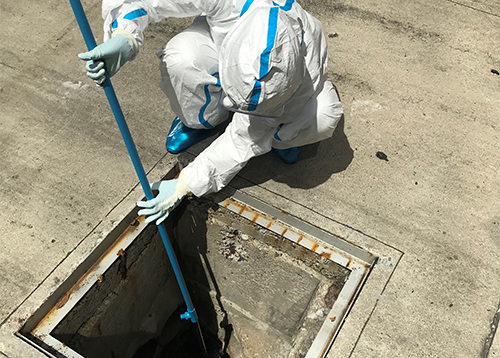Hunting for COVID-19 Answers in Thailand’s Wastewater
Summary
Based in Thailand, U.S. CDC’s Dr. Ong-orn Prasarnphanich is part of a global army of scientists trying to unravel the mysteries of the COVID-19 pandemic. When on assignment with colleagues from the Thai Ministry of Public Health (MOPH), she wears personal protective equipment from head to toe. Armed with a long pole, she scoops out samples of sewage water from a state quarantine facility so they can be tested to see if they contain the virus that causes COVID-19. COVID-19 was first reported in Thailand in January 2020 and remains a critical challenge.

Dr. Papassorn Pinyopornpanish, from Thailand’s Ministry of Public Health, works with CDC Thailand’s One Health Branch Chief, Dr. Ong-orn Prasarnphanich, taking samples of sewage water to test for the presence of the virus that causes
Sewage Testing is a Proven Tool for Disease Detectives
While it may not sound like the most glamorous assignment, sewage testing has been used for decades as an important method to find evidence of diseases such as polio. So, it wasn’t really a surprise when health officials in Thailand began looking for evidence of COVID-19 in sewage, says Dr. Prasarnphanich.
“CDC Thailand has supported and worked with partners at the Thai Department of Disease Control, Department of Livestock Development, and Chulalongkorn University in Thailand to conduct sewage surveillance at state quarantine facilities in Bangkok since October 2020,” Dr. Prasarnphanich adds.
Sewage surveillance can help track how and where COVID-19 is spreading. It helps health officials identify where people with COVID-19 live. While it cannot specifically identify which person is sick, it can tell health officials where to test people and find those infected earlier than other traditional surveillance systems do. This reduces the chance of spreading the disease to others.
Dr. Prasarnphanich’s study is looking for new ways to screen communities for a COVID-19 outbreak that will work best in Thailand and the surrounding region.
COVID-19 and One Health
Part of the U.S. CDC’s global health mission is reducing the impact of disease outbreaks and other public health events by increasing the rapid response to global health emergencies with staff posted around the world. This includes the country office in Thailand, which has supported local health officials in many ways since the beginning of the COVID-19 pandemic.
This is where Dr. Prasarnphanich’s expertise as a veterinarian, who specializes in veterinary public health and animal disaster management in low and middle income countries, is so valuable. She is the CDC’s One Health Branch Chief based in Bangkok, Thailand and works all over Southeast Asia. One Health focuses on preventing, detecting, and responding to infectious diseases that spread from animals to humans and are of greatest concern.
Coronaviruses: Old and New
There are seven coronaviruses known to make people sick. Four have been around since the 1960s and cause the common cold. Two newer coronaviruses that first infected animals and then spread to humans – Severe Acute Respiratory Syndrome (SARS) and Middle East Respiratory Syndrome (MERS) –have only been around since the early 2000s. The seventh coronavirus, SARS-CoV-2, causes COVID-19 and is responsible for the current pandemic.
Over the past year and a half since the COVID-19 pandemic began, bats and pangolins have been examined as possible carriers of the virus that spread to humans.
Learning from Past Experience
When SARS was discovered in China in 2003, researchers found parts of the coronavirus causing that outbreak in feces taken out of wastewater or sewage.
Researchers in Thailand wanted to see if the same was true for SARS-CoV-2. Dr. Prasarnphanich and other disease detectives collected wastewater samples from 12 hotels that served as state quarantine facilities in Bangkok. Follow-up visits to collect samples are ongoing.
Identifying Best Testing Methods
Researchers are also trying to define the best way to test the sewage samples because international guidance did not exist when the pandemic began.
“We are working with two laboratories in Thailand,” says Dr. Prasarnphanich, “one at the Chulalongkorn University in Bangkok and one at the Thai National Institute of Animal Health (NIAH) under the Department of Livestock Development. They each use different methods to test sewage samples. The method used by NIAH is similar to the one used to test for bird flu viruses.”
“We hope the results will tell us what the future use of wastewater surveillance in Thailand will look like,” says Dr. Prasarnphanich. She adds that the way these testing methods are used is unique to circumstances in Thailand. It’s important to know which process works best. Dr. Prasarnphanich hopes the research will be published and incorporated into international testing guidelines to help track down how and where COVID-19 and future diseases are spreading among the population and within a community.
CDC Thailand is now working with Thailand’s Department of Disease Control to plan for the next phase of this research.